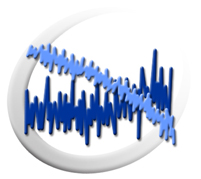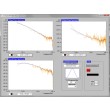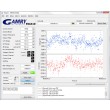The Electrochemical Signal Analyzer Software is designed specifically for the acquisition and analysis of time-dependent electrochemical noise signals. Cell voltage and current are continuously monitored at rates from 0.1 Hz to 1 kHz. An Electrochemical Signal Analyzer system can be configured as a potentiostat, galvanostat or ZRA. A full featured set of analysis tools provides powerful analysis features such as statistical analysis, detrending, impedance spectra, and histogram analysis.
Software
Product Details
Overview
Electrochemical noise, the current and voltage signals arising from freely corroding electrochemical systems, has been studied for over 25 years. Despite this experience, it often suffers from invalid data acquisition and inconsistent analysis.
The Electrochemical Signal Analyzer is designed to address both the past problems and the future needs of electrochemical noise measurements. Its primary goal is to assist in the evaluation of noise as a technique for the routine study of chemical processes. It combines a convenient package for versatile data acquisition with sophisticated data analysis.
For acquisition, this software partners with a Gamry potentiostat to generate reliable data in either potentiostatic, galvanostatic, or zero resistance ammeter (ZRA) mode. Careful attention is paid to sample continuity, acquisition rate, filtering, and autoranging to provide the most accurate signal representation.
To transform the measured noise into information, the Electrochemical Signal Analyzer Software provides an impressive package of signal analysis tools: blockwise statistics, Fourier and Maximum Entropy Method (MEM) frequency domain analysis, correlation analysis, histograms, and the powerful JFTA (Joint Time- Frequency Analysis). These algorithms can be used to calculate quantitative results from the data. When there is information buried in electrochemical noise, this software gives you the power to find it.
System Requirements
- Gamry Reference or Interface Family Instrument or other USB-based instrument compatible with the Gamry Framework Software
- Microsoft® Windows™ 10(32-bit or 64-bit) Required, Microsoft® Windows™ 11(32-bit or 64-bit) Recommended
- 16 GB RAM Required, 32 GB RAM Recommended
Noise Overview
Electrochemical Noise Overview
Various physical and chemical processes can give rise to seemingly random low-frequency signals. These phenomena include pitting and crevice corrosion, uniform corrosion, coating failure, inhibitor activity, cracking, passive film stability, adsorption, and gas generation. The potential and current fluctuations from these stochastic processes, taken as a group, are referred to as electrochemical noise.
Noise signals may be acquired in several ways. Performing the experiment with two identical electrodes under open-circuit conditions with a Zero Resistance Ammeter/ Electrometer allows a measurement to be made with no external perturbation, closely simulating ambient real-world conditions. Both potential and current can be measured simultaneously.
The Electrochemical Signal Analyzer Software can also be used in our unique Biased ZRA mode. Imposing a potential between two identical electrodes tends to move the anodic corrosion processes to the positively polarized electrode. This insures that more of the relevant current is measured. It also provides a useful way to electrochemically stress a material to measure its resistance to localized corrosion.
Some researchers find it advantageous to study the system under either potentiostatic or galvanostatic control to accelerate a particular process such as passivation. In this case, the current and potential, respectively, are monitored versus time. This software allows both potentiostatic and galvanostatic control in addition to ZRA mode.
The Electrochemical Signal Analyzer Software can also apply a computer-generated white noise signal to the system under test. While this may seem an anomaly for an electrochemical noise instrument, it is useful for improving the performance of the instrument when used for impedance analysis.
Data Acquisition Done Right
It is extremely important to differentiate the signals generated by the chemical process from the electronic noise of the instrument. We pay special attention to maintaining data integrity by using filters tuned to the sampling rate according to the Nyquist anti-aliasing criterion, which states that signals at frequencies greater than ½ the sampling frequency will appear as lower frequencies. High frequency computer noise is effectively eliminated in the Electrochemical Signal Analyzer Software by a series of analog and digital filters. The filters are designed to be linear in phase, insuring that peak shapes and higher order statistical moments are not distorted.
The Right Hardware for Signal Analysis
Electrochemical noise signals are often very small. This software utilizes the offset and gain capability of a Gamry Potentiostat to observe even the most subtle interactions. Think of this as using a magnifying glass to zoom in on a relatively stationary portion of your signal. A unique DC offset circuit subtracts out the background level so you can subsequently apply a final amplification to increase the signal of interest. These offsets and gains are calculated and adjusted continuously in the background during data acquisition to insure the signal of interest is always in focus.
To eliminate switching transients, a single potentiostat is dedicated to gathering data for one sample. To increase the productivity of your laboratory, the Electrochemical Signal Analyzer Software can control multiple Gamry potentiostats simultaneously, each running an independent noise experiment with different potentiostat ranges and settings.
The time-scale of an electrochemical noise measurement is difficult to predict. Accordingly, this software has been designed to monitor potential and current signals continuously in an uninterrupted fashion. If you wish, you can collect data for months! This way, you won’t miss any long-term events that may require an initiation period. You are literally limited only by the free space on your hard drive! To conserve space on your hard drive, we save the data as a binary file of voltage and current records.
The data can be collected at a selectable sampling rate from 1000 Hz to 0.1 Hz. The choice of data acquisition rate is dependent on the time scale of the phenomena being studied. Electrochemical Impedance Spectroscopy performed using the Gamry EIS300 is an excellent method to identify an appropriate sampling frequency.
Tools for Signal Analysis
Researchers are still studying signal analysis techniques to determine which are the most useful. To help you decide, we’ve supplied the Electrochemical Signal Analyzer Software with a versatile, inclusive collection of mathematical tools for signal analysis.
Data from noise experiments is acquired in the time domain, i.e., current and/or potential is measured versus time. For analysis, it is often convenient to convert these data to the frequency domain in which a function of the signal amplitude is plotted versus frequency. This spectral representation can be accomplished with the Fast Fourier Transform (FFT) or the Maximum Entropy Method (MEM).
Joint Time-Frequency Analysis (JTFA)
The Electrochemical Signal Analyzer Software includes Joint Time-Frequency Analysis, a powerful visual technique, for viewing and summarizing electrochemical noise data.
Traditionally, signals have been analyzed in either the time or the frequency domain. JTFA analyzes signals in both time and frequency domain at the same time. The amplitude of a signal is plotted as an intensity plot with the X-axis corresponding to time and the Y-axis corresponding to frequency.
In addition, the JFTA shows the original time series data and either instantaneous or overall spectra of the current and voltage signals for a powerful one chart summary of your signals.





